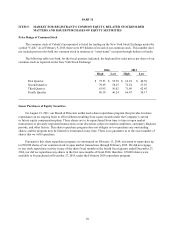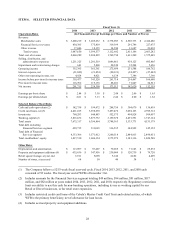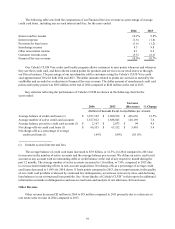Cabela's 2014 Annual Report Download - page 45
Download and view the complete annual report
Please find page 45 of the 2014 Cabela's annual report below. You can navigate through the pages in the report by either clicking on the pages listed below, or by using the keyword search tool below to find specific information within the annual report.35
having certain relationships with a hedge fund or private equity fund, subject to exemptions for certain permitted
activities. These regulations limit our ability to engage in the types of transactions covered by the Volcker Rule,
and may impose compliance, monitoring, and reporting obligations on us and WFB under certain circumstances.
Although the effective date of the regulations is April 1, 2014, the Federal Reserve approved an extension of the
conformance period until July 21, 2016, and has announced its intention to further extend the conformance period
until July 21, 2017. We are continuing to assess the impact, if any, that the Volcker Rule and the implementing
regulation will have on our Retail, Direct, and Financial Services segments, but we do not expect the Volcker Rule
to have a material impact on WFB’s securitization program.
The Cabela’s Master Credit Card Trust and related entities (collectively referred to as the “Trust”) is
structured to qualify for the exemption from the Investment Company Act of 1940, as amended (the “Investment
Company Act”) provided by Investment Company Act Rule 3a-7. On August 31, 2011, the SEC issued an advance
notice of proposed rulemaking regarding possible amendments to Investment Company Act Rule 3a-7. At this
time, it is uncertain what form the related proposed and final rules will take, whether the Trust would continue to
be eligible to rely on the exemption provided by Investment Company Act Rule 3a-7, and whether the Trust would
qualify for any other Investment Company Act exemption.
On August 27, 2014, the SEC adopted certain rules (“SEC Regulation AB II”) that will change the disclosure,
reporting, and offering process for public offerings of asset-backed securities, including those issued under WFB’s
securitization program. SEC Regulation AB II had been originally proposed by the SEC on April 7, 2010, and was
reproposed by the SEC on July 26, 2011. Among other things, SEC Regulation AB II imposes as a condition for
the shelf registration of asset-backed securities the filing of a certification concerning the disclosure contained in
the prospectus and the design of the securitization at the time of each offering off the shelf and the appointment
of a credit risk manager to review assets when credit enhancement requirements are not met or at the direction of
investors. As originally proposed and re-proposed, SEC Regulation AB II would have required the disclosure of
group-level data regarding the receivables in a credit card securitization, but this requirement was not included in
the final rule as adopted. There can be no assurances that the SEC will not require disclosure of group-level data in
credit card securitizations in the future. We are continuing to assess the impact of SEC Regulation AB II on WFB’s
securitization program.
On October 22, 2014, pursuant to the provisions of the Reform Act, the FDIC, the SEC, the Federal Reserve
and certain other federal agencies adopted regulations that impose a five percent risk retention requirement for
credit card securitizations that are issued after December 2016. We have not determined whether WFB’s existing
forms of risk retention will satisfy the regulatory requirements, whether structural changes will be necessary, or
whether the risk retention requirement will impact the Financial Services segment’s ability or desire to continue to
rely on the securitization market for funding.
On September 19, 2011, the SEC proposed a new rule under the Securities Act of 1933, as amended, to
implement certain provisions of the Reform Act. Under the proposed rule, an underwriter, placement agent, initial
purchaser, or sponsor of an asset-backed security, or any affiliate of any such person, shall not at any time within
one year after the first closing of the sale of the asset-backed security engage in any transaction that would involve
or result in any material conflict of interest with respect to any investor in a transaction arising out of such activity.
The proposed rule would exempt certain risk mitigating hedging activities, liquidity commitments, and bona fide
market-making activity. It is not clear how the final rule will differ from the proposed rule, if at all. The final rule’s
impact on the securitization market and the Financial Services segment is also unclear at this time.
Visa Litigation Settlement – In June 2005, a number of entities, each purporting to represent a class of retail
merchants, sued Visa and several member banks, and other credit card associations, alleging, among other things,
that Visa and its member banks violated United States antitrust laws by conspiring to fix the level of interchange
fees. In July 2012, the parties to this litigation entered into a settlement agreement to resolve the claims brought by
the class members. On December 13, 2013, the settlement received final court approval. We recognized a liability
at the end of 2012 for $12.5 million related to the settlement as a reduction of interchange income in the Financial
Services segment. At December 28, 2013, the remaining liability related to the settlement was $4.7 million,
which was settled in the first half of 2014; therefore, at December 27, 2014, there was no remaining liability for
this settlement.
























